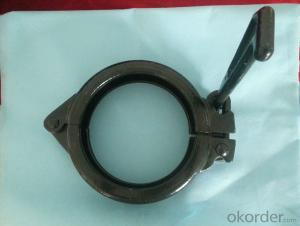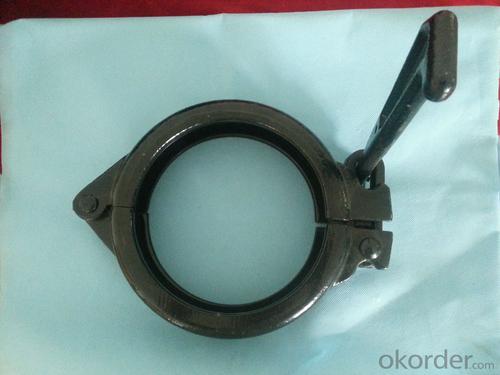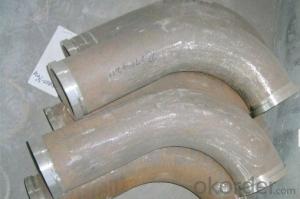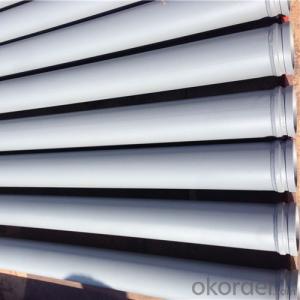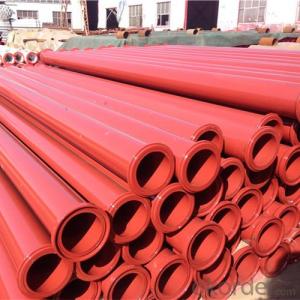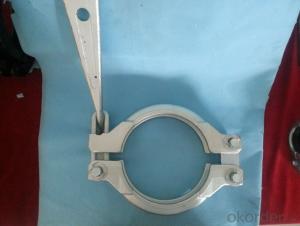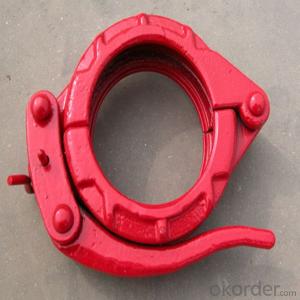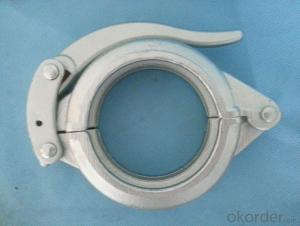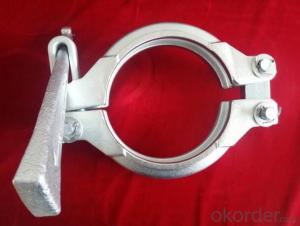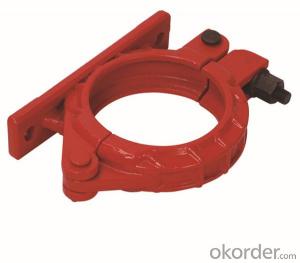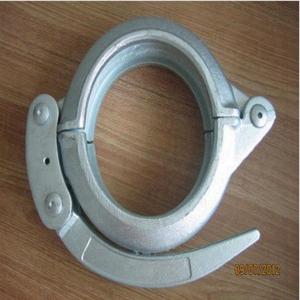Concrete Pump Clamp MF150 6
- Loading Port:
- China main port
- Payment Terms:
- TT OR LC
- Min Order Qty:
- 20 PCS
- Supply Capability:
- 1000 PCS/month
OKorder Service Pledge
OKorder Financial Service
You Might Also Like
Product Description:
A coupling is a device used to connect two delivery pieps together at their ends for the purpose of transmitting, and prevent the concrete from leaking. Couplings do not normally allow disconnection of shafts during operation.
Main Product Features:
1.Forged
2.2--8 inch
3.Galvanizing/Baking varnish
4.More durable,light,beautiful
Production steps:
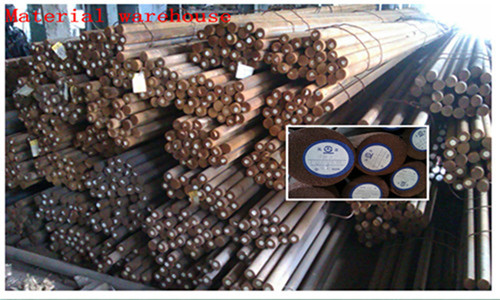

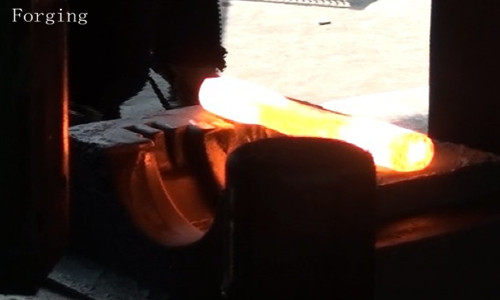
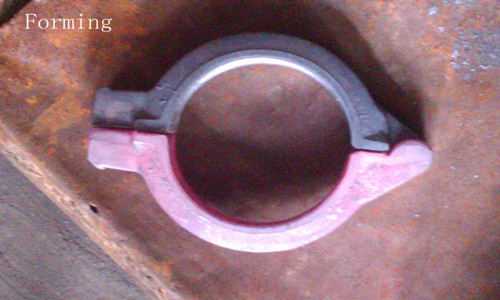

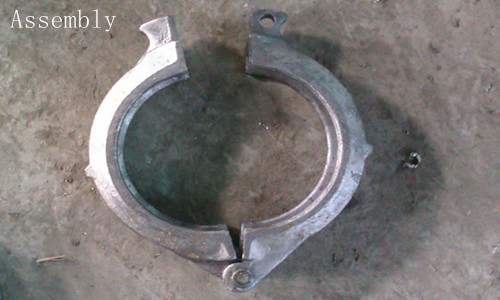
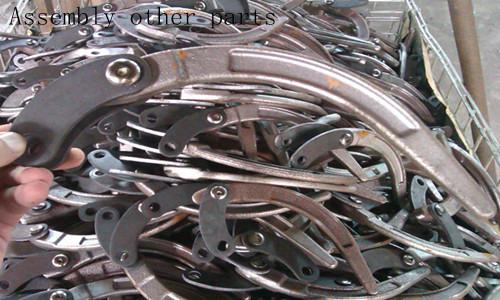
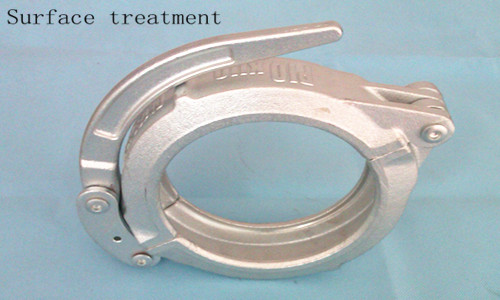
Concrete pump clamp Catalogue:
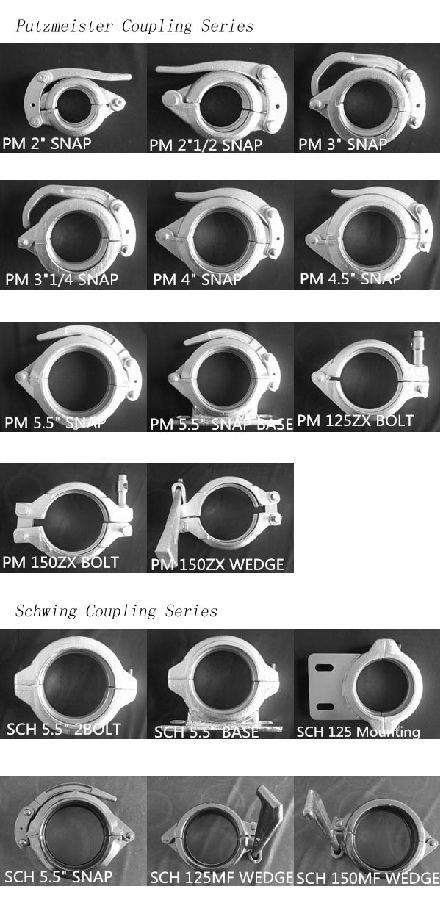
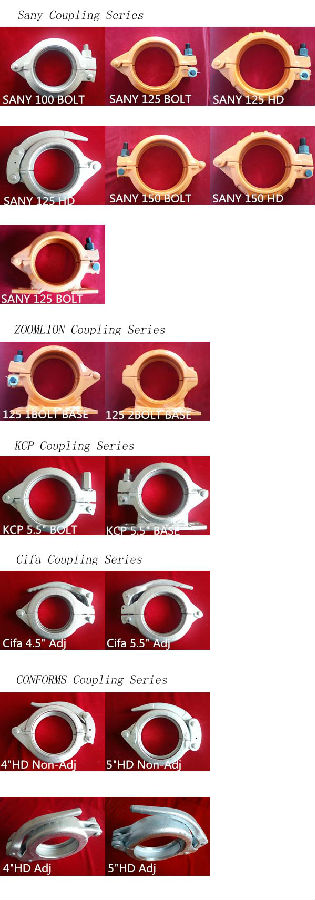
FAQ:
1.How do you regarding your product quality?
As our principle is more safety to save more. In China, there are lots of manufactures of this line, but we are the first one that use the forging technic in producing, firmly meet the PM standard.
2.Can I get some samples?
Of course you can. Small sample for free, but you pay the express. For some products are not small, like concrete pump pipe, it’s very difficult to deliver one pipe of 3000mm. If it’s possible, we’d like that you can come here to visit our factory. Welcome!
3. I want to make our logo on the products, is that ok?
Yes, it’s totally ok. OME is available from us.What you should do is send your logo, brand name, or picture to us. And let other things leave on us.
- Q: Can concrete pump spare parts be coated with anti-corrosion or anti-wear coatings?
- Yes, concrete pump spare parts can be coated with anti-corrosion or anti-wear coatings. These coatings help protect the parts from the corrosive nature of concrete or the wear and tear caused by continuous pumping. The coatings can extend the lifespan of the spare parts and improve their performance and durability.
- Q: Are there any specific tools required for replacing concrete pump spare parts?
- Yes, there are specific tools required for replacing concrete pump spare parts. These tools typically include a wrench set, pliers, screwdrivers, hammer, hydraulic jack, grease gun, and a welding machine. Additionally, specialized tools such as a concrete pump cleaning ball and pipe wrench may be required depending on the specific spare part being replaced.
- Q: What is the role of a concrete pump seal?
- The role of a concrete pump seal is to prevent leakage and maintain the pressure within the pumping system. Concrete pumps are used to transfer liquid concrete from one location to another, typically from a mixer truck to a construction site. These pumps operate under high pressure to ensure the concrete flows smoothly through the pipeline. A concrete pump seal is a vital component that helps maintain the integrity of the pumping system. It is usually made of durable materials such as rubber or polyurethane, designed to withstand the high pressures and abrasive nature of concrete. The seal is located at the connection points between various sections of the pipeline, including the pump, pipeline joints, and hose connections. The primary function of the seal is to prevent concrete from leaking out of the system. Concrete is a viscous material, and any leakage can cause significant problems, such as a decrease in pumping efficiency, wastage of concrete, and potential damage to the surrounding environment. The seal ensures that the pumping system remains leak-free, allowing for efficient and continuous concrete transfer. Additionally, the seal helps maintain the required pressure within the pumping system. Concrete pumps rely on consistent pressure to ensure the concrete is delivered smoothly and evenly. Any pressure loss due to leakage can lead to uneven flow or blockages in the pipeline, affecting the overall performance of the pump. By sealing the connection points, the seal helps maintain the desired pressure, ensuring the concrete is pumped efficiently. Overall, the role of a concrete pump seal is to prevent leakage, maintain pressure, and ensure the smooth and efficient transfer of concrete from the source to the destination. It is an essential component that contributes to the overall effectiveness and reliability of concrete pumping operations.
- Q: What are the signs of a clogged or damaged hydraulic filter?
- Some signs of a clogged or damaged hydraulic filter may include decreased hydraulic system performance, increased noise or vibration, higher operating temperatures, and contamination of the hydraulic fluid.
- Q: How can one determine the correct viscosity and temperature range for lubricants used in concrete pump spare parts?
- Determining the correct viscosity and temperature range for lubricants used in concrete pump spare parts involves considering several factors. Here are some steps to help you determine the appropriate viscosity and temperature range: 1. Consult the manufacturer's guidelines: The first step is to refer to the manufacturer's recommendations or guidelines for the specific concrete pump spare parts. The manufacturer may provide specific viscosity and temperature range requirements for the lubricants used in their equipment. 2. Understand the operating conditions: It is crucial to have a clear understanding of the operating conditions in which the concrete pump spare parts will be used. Factors such as ambient temperature, pump speed, load, and pressure should be considered. These factors can significantly impact the lubricant's viscosity requirements and temperature range. 3. Consider the lubricant's performance characteristics: Different lubricants have varying performance characteristics that make them suitable for specific applications. Look for lubricants that are specifically formulated for heavy-duty applications, provide excellent wear protection, and have good thermal stability. These performance characteristics will ensure that the lubricant can withstand the demanding conditions of a concrete pump. 4. Viscosity requirements: The viscosity of a lubricant is a critical factor in ensuring proper lubrication and protection of the concrete pump spare parts. Higher viscosity lubricants are generally recommended for heavy-duty applications, whereas lower viscosity lubricants are suitable for lighter loads. The viscosity requirements may also vary based on the specific pump parts, such as bearings, gears, or seals. Referring to the manufacturer's guidelines and consulting with lubricant suppliers can help determine the ideal viscosity range for the concrete pump spare parts. 5. Temperature range: The temperature range in which the concrete pump operates is another crucial aspect to consider. Lubricants should be able to maintain their viscosity and performance across the expected temperature range. Extreme temperatures can cause lubricants to lose their effectiveness, leading to equipment damage or failure. Therefore, it is important to select lubricants that have a temperature range suitable for the operating conditions of the concrete pump. 6. Seek expert advice: If you are unsure about the correct viscosity and temperature range, it is always advisable to consult with lubricant manufacturers, suppliers, or industry experts. They can provide valuable insights and recommendations based on their expertise and experience with concrete pump spare parts. By considering the manufacturer's guidelines, understanding the operating conditions, evaluating the lubricant's performance characteristics, and seeking expert advice, you can determine the correct viscosity and temperature range for lubricants used in concrete pump spare parts. This will help ensure optimal lubrication and prolong the lifespan of the equipment.
- Q: How do I troubleshoot issues related to concrete pump spare parts control systems?
- To troubleshoot issues related to concrete pump spare parts control systems, it is important to follow a systematic approach. Here are some steps you can take: 1. Identify the problem: Begin by clearly identifying the issue you are experiencing with the control system. Is it not working at all? Are there specific functions or components that are not functioning correctly? Understanding the problem will help guide your troubleshooting efforts. 2. Check power supply: Ensure that the control system is receiving proper power supply. Check the power source, circuit breakers, and fuses to ensure there are no interruptions or faults in the electrical supply. If needed, replace or repair any faulty components. 3. Inspect connections: Examine the wiring connections and terminals within the control system. Loose or damaged connections can cause issues with the functioning of the system. Tighten any loose connections and repair or replace any damaged wiring. 4. Review control settings: Verify that the control settings are correctly adjusted according to the manufacturer's specifications. Incorrect settings can lead to malfunctions or inefficient operation. Consult the user manual or contact the manufacturer for guidance on proper control settings. 5. Perform diagnostic tests: Many control systems have built-in diagnostic features or error codes that can help identify specific issues. Consult the system's manual to understand how to access and interpret these diagnostic tools. Run any recommended diagnostic tests to pinpoint the problem area. 6. Inspect sensors and actuators: Sensors and actuators play a crucial role in the control system's operation. Check these components for any damage, misalignment, or malfunctioning. Clean or replace sensors as needed and ensure the actuators are properly connected and functioning correctly. 7. Consult technical support: If you have followed the above steps and are still unable to resolve the issue, it may be helpful to contact the manufacturer's technical support team. They can provide expert guidance on troubleshooting the specific control system and may suggest additional steps or solutions. Remember to always prioritize safety when troubleshooting control systems. Ensure that the pump is turned off and disconnected from the power source before working on any electrical components. If you are unsure or uncomfortable with any troubleshooting steps, it is best to seek professional assistance.
- Q: What are the indications of a weak or dead remote control battery?
- The indications of a weak or dead remote control battery can vary depending on the type of remote control being used. However, some common indications include a noticeable decrease in the range or distance at which the remote control can operate. This means that you may need to be closer to the device you are trying to control in order for the remote to work properly. Another indication is when the remote control buttons become unresponsive or require multiple presses to function. You may also notice a delay in the response time of the device when using the remote control. In some cases, the remote control may stop functioning altogether, indicating that the battery is completely dead. If you experience any of these signs, it is recommended to replace the battery in the remote control to ensure reliable performance.
- Q: When concrete is poured, how high can the concrete pump be put?
- General building pouring concrete, height of automobile pump for the arm length minus 20 meters (consider horizontal movement of pump truck, leaving the house distance consumed that is to say, the arm length) 40 meters long arm pump car is 20 meters high, 60 meters long arm pump car for the height of 40 meters
- Q: Can I get spare parts for concrete pump wear plates and cutting rings?
- Yes, you can definitely get spare parts for concrete pump wear plates and cutting rings. These parts are essential for the smooth operation and performance of a concrete pump. Many manufacturers and suppliers specialize in providing spare parts for concrete pumps, including wear plates and cutting rings. You can contact these suppliers or manufacturers directly to inquire about the availability and pricing of these spare parts. Additionally, there are also online platforms and marketplaces where you can find a wide range of spare parts for various concrete pump models. It is always recommended to ensure that you purchase genuine and high-quality spare parts to guarantee the longevity and efficiency of your concrete pump.
- Q: How can one source reliable suppliers for concrete pump spare parts?
- One can source reliable suppliers for concrete pump spare parts by following a few steps. Firstly, it is important to conduct thorough research on potential suppliers. This can be done by searching online directories, industry forums, and marketplaces dedicated to construction equipment and spare parts. Reading customer reviews and ratings can provide valuable insights into the reliability and quality of the suppliers. Secondly, it is advisable to reach out to industry professionals and experts who have experience in the concrete pump industry. They can provide recommendations and references for reliable suppliers they have worked with in the past. Additionally, attending trade shows and exhibitions related to the construction industry can be a great way to connect with suppliers and evaluate their product offerings in person. This allows for direct communication and the opportunity to assess the reliability and quality of their spare parts. Moreover, it is essential to request samples or product catalogs from potential suppliers to ensure that the spare parts meet the required specifications and quality standards. This can help in assessing the reliability of the suppliers and the compatibility of their products with the concrete pump. Furthermore, conducting background checks on the suppliers is crucial. Verifying their credentials, certifications, and licenses can provide assurance of their reliability and professionalism. It is also beneficial to inquire about their manufacturing processes and quality control measures to ensure the consistency and durability of the spare parts. Lastly, comparing prices, warranties, and after-sales services offered by different suppliers can help in making an informed decision. It is important to strike a balance between the cost and the reliability of the suppliers to ensure a long-term and fruitful partnership. By following these steps and taking the time to thoroughly evaluate and research potential suppliers, one can source reliable suppliers for concrete pump spare parts and ensure the smooth operation and maintenance of their equipment.
Send your message to us
Concrete Pump Clamp MF150 6
- Loading Port:
- China main port
- Payment Terms:
- TT OR LC
- Min Order Qty:
- 20 PCS
- Supply Capability:
- 1000 PCS/month
OKorder Service Pledge
OKorder Financial Service
Similar products
Hot products
Hot Searches
Related keywords
